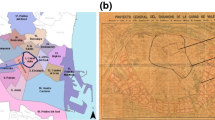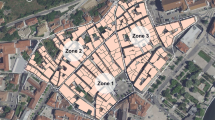Abstract
Al Hoceima is one of the most seismic active regions in north of Morocco. It is demonstrated by the large seismic episodes reported in seismic catalogs and research studies. However, seismic risk is relatively high due to vulnerable buildings that are either old or don’t respect seismic standards. Our aim is to present a study about seismic risk and seismic scenarios for the city of Al Hoceima. The seismic vulnerability of the existing residential buildings was evaluated using the vulnerability index method (Risk-UE). It was chosen to be adapted and applied to the Moroccan constructions for its practicality and simple methodology. A visual inspection of 1102 buildings was carried out to assess the vulnerability factors. As for seismic hazard, it was evaluated in terms of macroseismic intensity for two scenarios (a deterministic and probabilistic scenario). The maps of seismic risk are represented by direct damage on buildings, damage to population and economic cost. According to the results, the main vulnerability index of the city is equal to 0.49 and the seismic risk is estimated as Slight (main damage grade equal to 0.9 for the deterministic scenario and 0.7 for the probabilistic scenario). However, Moderate to heavy damage is expected in areas located in the newer extensions, in both the east and west of the city. Important economic losses and damage to the population are expected in these areas as well. The maps elaborated can be a potential guide to the decision making in the field of seismic risk prevention and mitigation strategies in Al Hoceima.















Similar content being viewed by others
References
Ait Brahim L, Tadili B, Nakhcha C, Mouayn I, Ramdani M, Limouri M, El Qadi A, Sossey Alaoui F, Benhalima M (2004) Using active faults and seismicity for the strong motion modeling in the eastern Rif (northern Morocco). Pure Appl Geophys 161(2004):1081–1091. doi:10.1007/s00024-003-2487-9
Akoglu AM, Cakir Z, Meghraoui M, Belabbes S, El Alami SO, Ergintav S, Akyüz HS (2006) The 1994–2004 Al Hoceima (Morocco) earthquake sequence: conjugate fault ruptures deduced from InSAR. Earth Planet Sci Lett 252(3–4):467–480. doi:10.1016/j.epsl.2006.10.010
ATC-13 (1985) Earthquake damage evaluation data for California, ATC-13. Applied Technology Council, Redwook City
BAEL 91 (1992) Règles techniques de conception et de calcul des ouvrages et constructions en béton armé suivant la méthode des états-limites. Décret n092-72 du 16 janvier 1992
Bard PY (1997) Local effects on strong motion ground motion: basic physical phenomena and estimation methods for microzoning studies. In: SERINA: seismic risk and integrated seismological, geotechnical and structural approaches. ITSAK, European Commission, Directorate General for Science and Development
Benedetti D, Petrini V (1984) Sulla vulnerabilitá sismica di edifici in muratura: proposte di un metodo di valutazione. L’industria delle Construzioni 149:66–78
Bezzeghoud M, Buforn E (1999) Source parameters of the 1992 Melilla (Spain, Mw = 4.8), 1994 Al Hoceima (Morocco Mw = 5. 8) and Mascara (Algeria, Mw = 5.7) earthquakes and seismotectonic implications. Bull Seismol Soc Am 89:359–372
Casado CL, Henares J, Badal J, Peláez JA (2014) Multifractal images of the seismicity in the Ibero-Maghrebian region (westernmost boundary between the Eurasian and African plates). Tectonophysics 627(2014):82–97
Cherkaoui T, El Hassani A (2012) Seismicity and seismic hazard in Morocco 1901–2010. Bulletin de l’Institut Scientifique, Rabat, section Sciences de la Terre 2012(34):45–55
Cherkaoui T, Hatzfeld D, Jebli H, Medina F, Caillot V (1990) Etude microsismique dela région d’Al Hoceima. Bull Inst Sci Rabat 4:25–34
Choubert G, Faure-Muret A (1984) Carte géologique du Rif: Al Hoceima-Echelle 1/50 000. No 302
Coburn A, Spence R (2002) Earthquake protection, 2nd edn. Wiley, Chichester
Corella PM (2004) Al-Hoceima earthquake. Field report
d’Acremont E, Gutscher M-A, Rabaute A, Mercier de Lépinay B, Lafosse M, Poort J, Ammar A, Tahayt A, Le Roy P, Smit J, Do Couto D, Cancouët R, Prunier C, Ercilla G, Gorini C (2014) High-resolution imagery of active faulting offshore Al Hoceima, Northern Morocco. Tectonophysics 632:160–166. doi:10.1016/j.tecto.2014.06.008
El Alami SO, Tadili BA, Cherkaoui TE, Medina F, Ramdani M, Ait Brahim L, Har-nafi M (1998) The Al Hoceima earthquake of May 26, 1994 and its aftershocks: a seismotectonic study. Ann. Geofisica 41:519–537
Faccioli E (2006) Seismic hazard assessment for derivation of earthquake scenarios in Risk-UE. Bull Earthq Eng 4:341–364
Faradi (2004) Seisme d’Al Hoceima du 24-2-2004 constat technique, p 3
Giovinazzi S, Lagomarsino S (2002) Wp04: guidelines for the implementation of the level I methodology for the vulnerability assessment of current buildings. RISK-UE project: an advanced approach to earthquake risk scenarios with applications to different European towns. Contract No. EVK4-CT-2000-00014, Genoa
Goula X, Gonzalez M (2004) Visite technique à la zone endommagé par le séisme d’Al-hoceima du 24 février 2004. Generalitat de Catalunya. Institut Cartogràfic de Catalunya, ICC-GS-192/2004 (fr)
Grünthal G (1998) European macroseismic scale 1998. Centre Européen de Géodynamique et de Séismologie, Luxemburg
HAZUS (1999) Earthquake loss estimation methodology technical manual, prepared by the National Institute of Building Sciences for Federal Emergency Management Agency (FEMA), Washington, DC
Jabour N, Kasmi M, Menzhi M, Birouk A, Hni L, Hahou Y, Timoulali Y, Bedrane S (2004) The February 24th, 2004 Al Hoceima earthquake, Newsletter of European-Mediterranean Seismological Centre, No 21, ISSN:1607-1980
Lagomarsino S, Giovinazzi S (2006) Macroseismic and mechanical models for the vulnerability and damage assessment of current buildings. Bull Earthq Eng 4:415–443
Lantada N, Irizarry J, Barbat AH, Goula X, Roca A, Susagna T, Pujades LG (2010) Seismic hazard and risk scenarios for Barcelona, Spain, using the Risk-UE Vulnerability Index Method. Bull Earthq Eng. doi:10.1007/s10518-009-9148-z
Louhibi S, Chourak M, El Kihel E, El Hammoumi A, Douiri A (2013) Evaluation of the seismic vulnerability of buildings in Al Hoceima (Morocco). Int J Earth Sci Eng. 06(01):1505–1511. ISSN:0974-5904
Lungu D, Aldea A, Arion A, Vacareanu R, Petrescu F, Cornea T (2001) WP1 report: European distinctive features, inventory database and typology. RISK-UE project: an advanced approach to earthquake risk scenarios with applications to different European towns. Contract No. EVK4-CT-2000-00014
Milutinoviç ZV, Trendafiloski GS (2003) WP04: vulnerability of current buildings handbook. RISK-UE project: an advanced approach to earthquake risk scenarios with applications to different European towns. Contract No. EVK4-CT-2000-00014, Institute of Earthquake Engineering and Engineering Seismology (IZIIS), Skopje
Mourabit T, Abou Elenean KM, Ayadi A, Benouar D, Ben Suleman A, Bezzeghoud M, Cheddadi A, Chourak M, ElGabry MN, Harbi A, Hfaiedh M, Hussein HM, Kacem J, Ksentini A, Jabour N, Magrin A, Maouche S, Meghraoui M, Ousadou F, Panza GF, Peresan A, Romdhane N, Vaccari F, Zuccolo E (2013) Neo-deterministic seismic hazard assessment in North Africa. J Seismol. doi:10.1007/s10950-013-9375-2
Mouroux P, Bertrand M, Bour M, Brun BL, Depinois S, Masure P, Risk-UE Team (2004) The European Risk-UE project: an advanced approach to earthquake risk scenarios. In: Proceedings of the 13th world conference earthquake engineering, Vancouver (CD-ROM, paper no. 3329)
Pitilakis K, Alexoudi M, Argyroudis S, Anastasiadis A (2006) Seismic risk scenarios for an efficient seismic risk management: the case of Thessaloniki (Greece). Adv Earthq Eng Urban Risk Reduct. doi:10.1007/1-4020-4571-9_15
Poujol A, Ritz J-F, Tahayt A, Vernant P, Condomines M, Blard P-H, Billant J, Vacher L, Tibari B, Hni L, Koulali Idrissi A (2014) Active tectonics of the Northern Rif (Morocco) from geomorphic and geochronological data. J Geodyn 77:70–88. doi:10.1016/j.jog.2014.01.004
PS92 (1995) Règles PS applicables aux bâtiments. NF P 06-013-DTU Règles PS 92, Décembre 1995
RGPH 2004 (2004) Recensement général de la population et de l’habitat 2004. http://www.hcp.ma/Recensement-general-de-la-population-et-de-l-habitat-2004_a633.html
RGPH 2014 (2014) Population légale des régions, provinces, préfectures du royaume d’après les résultats du RGPH 2014 (12 Régions). http://www.rgph2014.hcp.ma/Note-sur-les-premiers-resultats-du-Recensement-General-de-la-Population-et-de-l-Habitat-2014_a369.html
RMSI (2012) Morocco natural hazards probabilistic analysis and national strategy development. Earthquake hazard report. Department of Economic and General Affairs, Kingdom of Morocco
R.P.S. 2000 (2002) Règlement de construction parasismique. Ministère de l’Aménagement du Territoire, de l’Urbanisme, de l’Habitat et de l’Environnement. Secrétariat d’Etat à l’Habitat
R.P.S. 2000, Version 2011 (2011) Règlement de construction parasismique. Ministère de l’Habitat, de l’Urbanisme et de l’Aménagement de l’Espace
Secanell R (1999) Avaluació de la perillositat sísmica a Catalunya: anàlisi de sensibilitat per a diferents models d’ocurrència i paràmetres sísmics, Ph.D. thesis, University of Barcelona
Tahayt A, Feigl KL, Mourabit TL, Rigo A, Reilinger R, McClusky S, Fadil A, Dorbath L, Serroukh M, Gomez F, Ben Sari D, Berthier E (2009) The Al Hoceima (Morocco) earthquake of 24 February 2004, analysis and interpretation of data from ENVISAT ASAR and SPOT5 validated by ground-based observations. Remote Sens Environ 113(2009):306–316. doi:10.1016/j.rse.2008.09.015
Talhaoui A, Brahim AI, Aberkan MH, Kasmi M, El Mouraouah A (2008) Seismic microzonation and site effects at Al Hoceima city, Morocco. J Earthq Eng 8(4):585–596
USGS (2016) M6.3-50 km NNE of Al Hoceima, Morocco. http://earthquake.usgs.gov/earthquakes/eventpage/us10004gy9#general_region
Woerd JVD, Dorbath C, Ousadou F, Dorbath L, Delouis B, Jacques E, Tapponnier P, Hahou Y, Menzhi M, Frogneux M, Haessler H (2014) The Al Hoceima Mw 6.4 earthquake of 24 February 2004 and its aftershocks sequence. J Geodyn 77:89–109. doi:10.1016/j.jog.2013.12.004
Acknowledgments
This research benefited from the ICTP-OEA (Trieste) Programme in the framework of the North African Group for Earthquake and Tsunami studies (NAGET) activities. We also thank two anonymous reviewers’ valuable comments which helped to improve this paper.
Author information
Authors and Affiliations
Corresponding author
Rights and permissions
About this article
Cite this article
Cherif, Se., Chourak, M., Abed, M. et al. Seismic risk in the city of Al Hoceima (north of Morocco) using the vulnerability index method, applied in Risk-UE project. Nat Hazards 85, 329–347 (2017). https://doi.org/10.1007/s11069-016-2566-8
Received:
Accepted:
Published:
Issue Date:
DOI: https://doi.org/10.1007/s11069-016-2566-8




